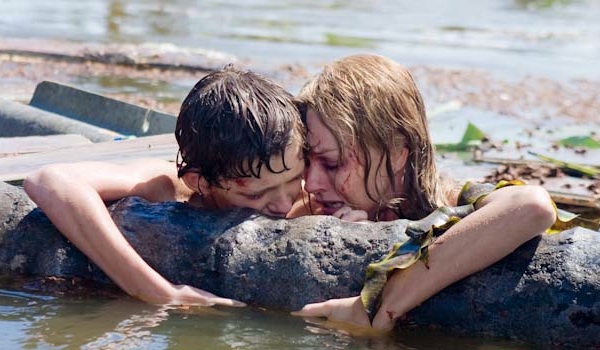The Impossible Review
The Impossible tells a very micro-level story about one of the greatest natural disasters in human history. It’s set before, during, and after the 2004 Boxing Day tsunami that affected men and women in dozens of countries on the Indian Ocean, including Thailand, where Henry (Ewan McGregor), Maria (Naomi Watts), and their three children are vacationing.
The film is equal parts genuinely moving and overtly manipulative. Director J.A. Bayona (The Orphanage) must have known he had a good thing on his hands, but he pushes it a little too far. For every cathartic moment, there’s a close-up of two hands reaching desperately for the other while Fernando Valezquez’s score crescendoes the tears right out of your eyes. Still, there’s quite a bit of skill evident here—from the brilliantly conceived tsunami sequence to the disaster-inspired makeup and strong sound work that’ll make you feel drenched, cold, and alone.
Henry, Maria, and their family, though, are the heart and soul of the picture. When the tsunami strikes, Maria finds her oldest son, Lucas (Tom Holland), being pulled (like her) by the wildly strong currents. They manage to find safety in the form of a still-standing tree, but Maria’s leg has been torn open, and the filthy water makes it look infected almost instantly.
Henry, meanwhile, manages to track down his two younger sons, Thomas (Samuel Joslin) and Simon (Oaklee Pendergast), while they survey what’s left of their hotel, as well as every hospital and makeshift hospital nearby, for the bodies of Maria and Lucas.
Separation by such tragic and powerful forces in film virtually guarantees a tearful reunion, and The Impossible is no different. What’s interesting, though, is that the film is made up of a series of mini reunions. Bayona and screenwriter Sergio Sanchez (working from the true story of a Spanish family of five separated by the tsunami) manage to separate these characters over and over and over again to the point you wonder why they leave one another’s sides at all. Maria eventually needs medical attention for her leg wound (which is a sickening sight), and every time Lucas steps away from her bed to get water or something, his mother goes missing—taken into surgery or moved to a different wing of the hospital.
The same happens with Henry. He decides it’s no longer safe for Thomas and Simon to accompany him while he searches for Maria and Lucas, so he sends them away with a larger group of youngsters, in the company of other European tourists, for safer ground. Things don’t work out as planned, however, and Henry finds himself alone, injured, and searching for four instead of two missing family members.
Is this approach a successful one? Well, by the end of the film, you should feel sufficiently moved, but the big moment you know is coming feels a little underwhelming because it’s so drawn out. So many other aspects of the film come to life in exciting ways, however, that The Impossible‘s narrative hiccups are merely footnotes in this lovingly crafted human drama.
A list of The Impossible‘s most positive attributes begins with the tsunami scene, which is so masterfully done that even the most cynical viewer should find him or herself wrapped up in it. The performances, too, are mostly noteworthy. Naomi Watts is getting (and deserves) the most praise for her very physical work that earned her the film’s only Oscar nomination. Tom Holland, meanwhile, is revelatory in his first film role. He serves as a pillar of strength for his mother, yet he’s only a boy, no older than 14. We observe him, though, in quieter moments when he’s alone and afforded the opportunity to reflect on what he’s been through and the horrible things he’s seen.
From the craft perspective, too, the film is exemplary. There’s a sequence late in the film when Maria is reliving the moments just after the wave hit that those unfamiliar with Bayona’s work can see precisely what this guy is capable of. It’s a visceral rush of swirling water and debris that’s punctuated by the piercing red of Maria’s blood. And the sound work throughout the film gives everything a soggy, sopping wet feeling that gets under your skin in as feelingly as the film’s “bloody” good makeup.
The Impossible probably isn’t, nor should it be, film’s final word on the 2004 tsunami, but it’s, by and large, a damn good survival story. It also represents the Hollywood arrival of a big-time directorial talent. Next time Bayona has a film on the schedule, watch out. If he can shake some of the storytelling jitters that brought this film down ever so slightly, it’ll likely be one of its year’s best.
















